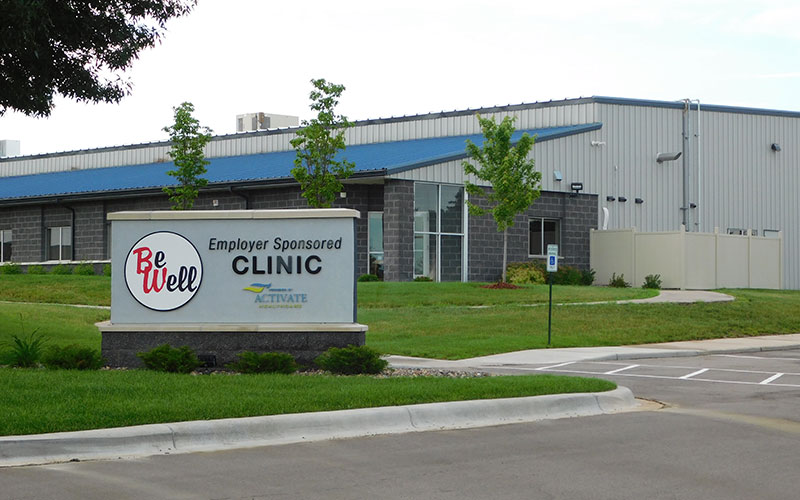by Lara Copeland, contributing writer, Plastics Business
Across the business landscape, companies are employing creative strategies to draw in new talent while also trying to hold onto current employees. Attractive incentives – like flexible hours and good pay – are among some of the leading priorities potential employees are looking for; however, affordable and unique healthcare packages also are top contenders. Some large corporations, like Amazon, Apple and Facebook, have been offering on-site health clinics for a number of years, but this growing trend is making its way into smaller companies, too.
Although the trend is growing now, offering on-site access to medical providers is nothing new. The concept goes back more than 150 years, when railroad and mining companies dominated much of the workforce. Due to the high rate of injuries within these industries, utilizing a company doctor simply made sense. As the next century rolled around, these company doctors became too costly, and their popularity all but died during the Great Depression. But with the manufacturing boom in the late 1930s, these dedicated physicians were once again widespread, and they have gained even more popularity with the rising cost of healthcare since the 2000s. The modern on-site health clinic not only treats injured employees, it now also addresses overall health and wellness.
Motivation for change
In January 2019, Vital Plastics, located in an industrial park just east of the Twin Cities metro area in Minnesota, became self-insured, offering healthcare, dental and short-term disability plans for its 112 part-time and 110 full-time employees and their families. Additionally, in July 2019, this custom injection molding and contract assembly company – along with two other businesses and a local school district – opened a shared, on-site health clinic.
According to Vital Plastics President George Hauser, two main factors motivated the company to make this move. “We looked at it as a differentiator,” he said. “At the time we started participating in this conversation, attracting and engaging employees was quite difficult. So, we did something to be different, look different and feel different – we wanted to be appealing to people so they could see the value in our company.”
Company-sponsored healthcare offered another advantage. “The other thing we were striving to do is to control our healthcare costs,” Hauser added. “Every year we are faced with increases, and it just wasn’t sustainable anymore.” He commented that becoming self-insured and offering the on-site clinic were two ways Vital Plastics could get control of its healthcare costs and establish transparency. The company had spent money in the past offering wellness services, like a mobile blood unit or offering a copay for health memberships, but Hauser found that those services weren’t getting much “lift,” as he put it. “We simply decided to redirect our dollars,” he explained.
The clinic is staffed with a couple of medical assistants and a nurse practitioner. It operates 40 hours each week, but its schedule is staggered so that it can accommodate employees from various shifts. And, despite being shared among four entities and a large pool of insureds, people are seen very quickly.
As for the self-insured healthcare plan, Hauser remarked that it is “virtually the same plan we had when we were insured through a regular carrier. The only difference now is we fund it ourselves and have a third-party administrator while also having an over-line protection to help protect us from catastrophic issues.”
Comprehensive benefits
Initially, Vital Plastics offered the clinic to employees who were on the company’s health insurance plan. “Anybody who was covered under the plan – whether it was a single or family plan – could utilize our on-site health clinic,” Hauser said. But that all changed with the recent pandemic. “Once COVID-19 hit, we started offering the on-site clinic to all full-time employees – even those not on our health insurance plan.” Vital Plastics paid for these employees to go to the clinic, realizing that healthcare may be more cost-prohibitive at the time when family budgets were under stress. “We wanted to at least pay for them to get into our clinic,” he explained. “That way they could have some access to free healthcare during these trying times.”
Additionally, the on-site clinic had COVID tests available much before the rest of the country. “When we were formulating our plan for moving forward during the pandemic back in March, we wanted to respond appropriately, including following CDC guidelines,” Hauser noted. The clinic obtained a dozen or so tests, and Hauser said he was happy to have them, despite the limited supply. “It was good to know that we would be able to test somebody should they become symptomatic; it felt good to be prepared long before the general public.”
The success stories surrounding Vital Plastics’ healthcare don’t begin or end with the pandemic; in fact, they reach into the employees’ families. For example, the spouse of an employee on the company’s health plan had been dealing with severe back issues that were determined to be spasms. Despite being unable to work due to his condition, he also was unable to get into his doctor for nearly a month. He decided to go to Vital Plastics’ on-site clinic, where the provider reviewed his circumstances and ended up prescribing a muscle relaxer. During his appointment, the provider also reviewed this patient’s list of medications. In the end, not only were his spasms calmed, but he also ended up saving over $300 a month on his other medications because they are provided free by the clinic.
Collaboration and compliance
Becoming self-insured and opening an on-site clinic still may be a rarity, but as healthcare costs go up, the concept continues to attract interest. For others looking to implement something similar, Hauser mentioned some facets that have worked well for Vital Plastics and what a company should think about when considering such a paradigm shift.
“We collaborate well with the other companies in our group, and we have the ability to customize our specific plan to meet our own needs,” he said. “I don’t have to offer the exact same plan as the others in our group, but some items do need to be the same.” He continued, saying that while another company in the group offers to cover part-time employees, Vital Plastics only covers full-time employees. “We also can set different copay prices, for example.”
Hauser also emphasized the importance of staying compliant with any health savings account (HSA) regulations. “With an HSA, we can’t offer the clinic for free, so we ended up doing preventive care for free,” he explained. In this case, any diagnostic care is a $25 copay, but Vital Plastics contributes enough to the HSAs for these copays to be covered. He said there’s “room for maneuvering, but make sure you remain compliant,” while also noting that it is “important to research vendors and make sure you know who your administrator and your clinic provider is.”
“Every single one of our plans is going well,” Hauser assured. “We are 17 months into the insurance plans and about 10 months into the clinic, and I can say that participation in each of these has increased over time.”
Vital Plastics is not resting on its laurels though. Already this year, the company added an incentive to its health savings account. If an employee goes to the on-site clinic for a physical, which is free, Vital Plastics makes an additional contribution to their HSA. “This has been well taken advantage of and well received,” Hauser noted.
As the company moves forward, controlling healthcare costs remains a top priority. “We did not increase health premiums in 2020, and if I stay on trajectory this year, I can hold healthcare costs again for another year,” Hauser commented. Vital Plastics also strives to create more responsibility for the user. As for now, he is pleased with all aspects of the company’s healthcare offerings. “We are ahead of the game with all of our healthcare plans – we were last year, and we are again this year. That tells me that we’re doing it right.”





